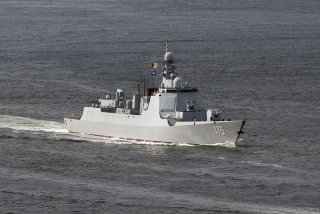China's Navy Is Quickly Modernizing: U.S. Government Report
Can America keep its relative advantage?
For the past 25 years, the China’s People’s Liberation Army Navy (PLAN) has been steadily modernizing. As a result, it has become a formidable military force within China’s near-seas regions, while it is now able to conduct a number of growing operations in more-distant waters including in the Western Pacific, the Indian Ocean and even in the waters around Europe.
According to a new Congressional Research Service Report released this month, this poses a major challenge to the U.S. Navy’s ability to achieve and maintain wartime control of blue-water ocean areas of the Western Pacific. This is the first such challenge the U.S. Navy has faced since the end of the Cold War, as China’s naval modernization efforts have substantially reduced the U.S. advantage.
The report, China Naval Modernization: Implications for U.S. Navy Capabilities Background and Issues for Congress, highlighted China’s efforts, which encompasses a wide array of platform and weapon acquisition programs.
According to the report, these include anti-ship ballistic missiles (ASBMs), anti-ship cruise missiles (ASCMs), submarines, surface ships, aircraft, unmanned vehicles (UVs), and supporting C4ISR (command and control, communications, computers, intelligence, surveillance, and reconnaissance) systems.
The report noted that there are several issues that Congress must take action on, including whether the U.S. Navy is responding appropriately to China’s naval modernization efforts and even if the planned size of the Navy will be appropriate to counter China, while also permitting the Navy to perform other missions, including countering Russian military forces and defending U.S. interests in the Middle East.
In addition, the report questioned whether the U.S. Navy should shift to a more distributed fleet architecture, which could improve the Navy’s ability to avoid and withstand attack from Chinese Anti-Access Area Denial (A2/AD) weapons technology.
Simply put, if current U.S. and Chinese naval capability trend lines do not change, the report warned that China might eventually draw even with or surpass the United States in overall naval capability.
However, the Congressional Research Service Report did not address that China’s naval growth will not be without its own issues.
Zi Yang, a senior analyst of Chinese studies in Singapore, argued in a recent article for The Diplomat that the “invisible threat” to the Chinese PLAN is little different from one of the causes of the fall of the Soviet Union three decades ago: corruption!
Zi noted that the recent arrest of Hu Wenming—the former chairman of China Shipbuilding Industry Corporation (CSIC), China’s leading military shipbuilding state-owned enterprise from 1999 to 2019—highlighted the very serious corruption that continues to exist among China’s military shipbuilders.
Pointedly, China’s naval modernization is far more complex than simple growth and the corruption among the shipbuilders will have lasting consequences for the PLAN. The more money that China invests in shipbuilding the more opportunities for corruption will emerge. The question will be whether Beijing can offer the necessary transparency to fight that corruption.
Peter Suciu is a Michigan-based writer who has contributed to more than four dozen magazines, newspapers and websites. He is the author of several books on military headgear including A Gallery of Military Headdress, which is available on Amazon.com.
Image: Reuters

